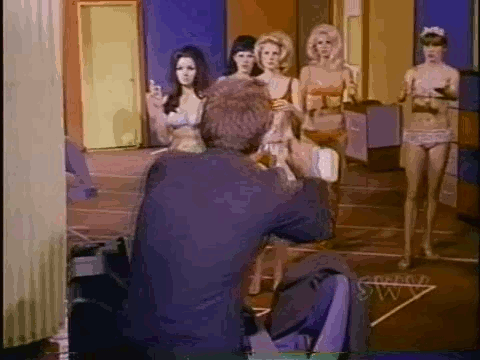One cinematic experience which I can’t say I’m too proud to have had, but which as a thaumatophile I guess I can’t quite ignore, is a lame sci-fi sex (but not too much of that) farce made in 1968 by Herschell Gordon Lewis called How to Make a Doll.
Now HGL does deserve a place of sorts in the cinematic pantheon as a gore pioneer, beginning in 1963 with Blood Feast, and he had earlier made some distinguished in the nudie-cutie/sexplotation field, for example with The Adventures of Lucky Pierre in 1961. But I’m sorry to say he was off his game when he came up with this one. (As to what he was on I hesitate to speculate, except to note that it was 1968.)
I am aware that I am at risk of brain bleeds trying even to think about the plot of this one, but here goes: ultra-nerd Dr. Corly can’t figure out women, but luckily for him he connects with horny elderly mad scientist Dr. West (hmm) who’s finally figured how to program a computer to do wish fulfillment that takes the form of producing “dream girls.” They aren’t lacking in the pretty department, but they seem rather dim in higher cognitive functions. Does anyone care? Not the people who made this movie, obviously. A lengthy and tediously chaste laboratory-floor make-out session follows, further followed by one of the very few actually interesting moments in the movie, when Dr. West decides to upload his consciousness into the computer, along with two dreamgirls, via a cheesy special effect.
Cue animated gif, naturally.
It would all be forgettable, save for one thing, which is that I think that this no-budget scene might be one of the very first instances of the concept of mind-uploading to be depicted cinematically. TV Tropes suggests one that is just a little earlier — March 1968 as opposed to the November 1968 release date for How to Make a Doll — in the original series Star Trek episode “The Ultimate Computer,” which had a computer the programming of which was based on the mental patterns of its human creator, but I’m not sure if that really counts — the creator didn’t transfer his consciousness somehow into the machine.
Anyway, even though Dr. West has managed to solve the really hard problem of duplicating his consciousness in a machine, he’s neglected to provide himself any synthetic means of interacting with the world outside the machine or a virtual reality playground within it (a pretty glaring oversight, I should think). So instead he arranges to live vicariously through Dr. Corly, whom he transforms into “one of the world’s great lovers.” In the context of this movie, being one of “the world’s great lovers” means having a bunch of brief necking sessions with a string of bikini-clad tootsies before running back to the lab to allow the disembodied Dr. Corly to participate in your recorded experiences.
Wouldn’t you know it, this squad of bikini-clad tootsies ends up being instantiated as real-world simulacra, all dim and robotic to the girl. Fortunately Dr. West discovers that you can banish them to nothingness them simply by tearing up the cardboard punch card on which each girl’s data is stored. (Since typical punch cards in 1968 stored 960 bits of data tops, perhaps it’s not surprising the simulacra were a little lacking in the personality department.) This is so damn weird it merits an animated gif of its own.
Perhaps TV Tropes needs a category called You Fail Metaphysics Forever just to deal with this.
I’ve shown you the sixty or so frames of this movie that count, but if you really, really must Something Weird Video does put out an edition of it.


